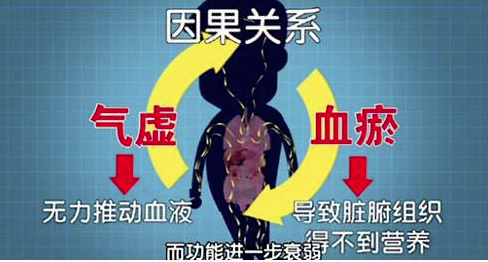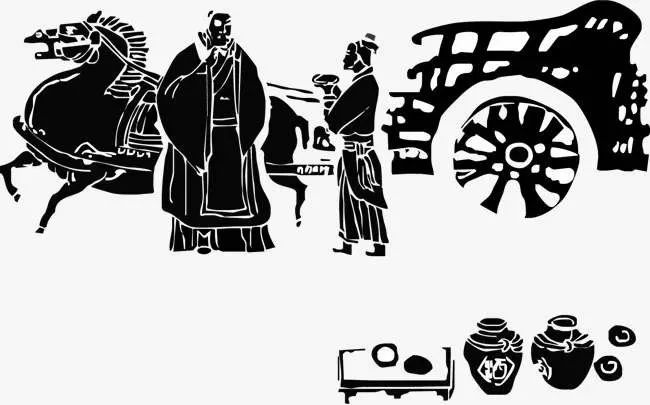Inheriting the legacy of Qi Huang, a public account with substance and warmth
Ai Yu Xiang Tang
Author: Gao Kejian, Department of Cardiology, Beichen Traditional Chinese Medicine Hospital, Tianjin University of Traditional Chinese Medicine

Introduction: Blood stasis syndrome (Xue Yu Zheng) is an extremely common condition in Traditional Chinese Medicine (TCM), and it is involved in almost all stages or processes of various Western medical conditions. TCM, unique to China, has a profound understanding of this syndrome, with over 2000 years of successful experience in differential diagnosis and treatment of various blood stasis syndromes. In recent years, research on blood stasis syndrome has deepened both domestically and internationally, yielding significant results. Numerous international academic conferences have been held on this topic. Many countries have recognized the remarkable efficacy of TCM in treating blood stasis syndrome and have applied it in clinical practice. However, many patients in China remain unaware of the origins and implications of blood stasis syndrome, preventing them from receiving the high-quality treatment that should be readily available. To further popularize understanding of this highly prevalent syndrome and improve national health, we aim to provide an overview of blood stasis syndrome.The causes of blood stasis syndrome are diverse, with the most common being Qi deficiency leading to blood stasis, Qi stagnation causing blood stasis, and cold congealing blood stasis. Analyzing from the perspective of Western medical basic theory, blood stasis syndrome often involves various pathological and physiological changes:1. It primarily manifests as reduced microcirculation function, with slowed blood flow in the microcirculation, obstruction, and pathological morphological abnormalities in blood vessels.2. The most common abnormality in blood stasis syndrome is a change in the quality of circulating blood, which can manifest as increased blood viscosity, elevated blood lipids, and other abnormal indicators in blood rheology.3. The presence of different types of atherosclerotic plaques can lead to narrowing of the arterial lumen in major organs, thereby promoting the phenomenon of blood circulation obstruction. Unstable plaques can often cause unstable angina and other acute coronary syndromes.4. On the basis of primary heart disease, the presence of blood stasis syndrome can exacerbate heart function decline, even leading to heart failure, characterized by severe palpitations, shortness of breath, edema, cyanosis of lips, jugular vein distension, and even difficulty breathing or inability to lie flat.5. Various vasoactive substances or endocrine hormones in the blood may exhibit qualitative and quantitative abnormalities. Commonly observed are elevated levels of catecholamines and endothelins, which are closely related to the formation and development of blood stasis syndrome.Diseases Associated with Blood Stasis Syndrome Blood stasis syndrome can be involved in most diseases across various clinical specialties, most commonly seen in internal medicine, particularly cardiovascular and cerebrovascular diseases. The most common conditions include various types of coronary heart disease, angina pectoris, myocardial infarction, asymptomatic myocardial ischemia, myocarditis, cardiomyopathy, pulmonary heart disease, congenital heart disease (especially those with cyanotic features), heart failure from various causes, microcirculatory disorders during shock, various arrhythmias, cerebral infarction, hyperviscosity syndrome, and hyperlipidemia. Other internal diseases also frequently accompany blood stasis syndrome, such as peptic ulcers and chronic gastritis in gastrointestinal diseases, and systemic lupus erythematosus in rheumatic diseases. Blood stasis syndrome is also commonly seen in certain endocrine and metabolic disorders, such as thyroid dysfunction and diabetes. Individuals who are often in poor mental states, especially those with depression or those who are easily agitated, are also prone to Qi and blood stagnation. Studies have shown that individuals with a strong competitive nature, often characterized as Type A personalities, tend to have higher levels of catecholamines in their blood, making them more susceptible to blood stasis syndrome. Severe neurosis leading to long-term insomnia may also be closely related to blood stasis syndrome, as evidenced by the rapid improvement in sleep of some patients with neurosis after continuous use of Xuefu Zhuyu capsules. Gynecological diseases often involve Qi and blood stagnation, with common conditions including dysmenorrhea, uterine fibroids, and endometriosis. Some skin diseases also exhibit characteristics of blood stasis syndrome. TCM conditions such as chest obstruction, palpitations, hypochondriac pain, bi syndrome, stroke, masses, dizziness, headaches, insomnia, blood disorders, depression, mania, stomach pain, hiccups, and abdominal pain are all more or less related to blood stasis syndrome. In our clinical practice, we have found that if Western medicine diagnoses confirm the presence of the aforementioned diseases or related abnormalities, and TCM differential diagnosis indicates blood stasis syndrome, then while treating these diseases, it is essential to actively use corresponding blood-activating and stasis-resolving medications. The results often yield a synergistic effect.Clinical Manifestations of Blood Stasis SyndromeCommon manifestations: Most patients exhibit varying degrees of pain, which is often quite pronounced. However, there are also a few patients who, based on the pathological and physiological basis of their disease, should exhibit significant pain but do not due to certain reasons, or the pain is not very noticeable, which should also be given sufficient attention in disease prevention and treatment. We plan to provide a specialized introduction in future articles.TCM manifestations: Regardless of the type of blood stasis syndrome, most patients experience significant pain, often localized. Other symptoms may include dizziness, and in severe cases, occasional fainting; skin may show purpura, and the complexion may appear dark, sometimes accompanied by rough skin and pigmentation. Some patients with blood stasis syndrome may present with nodules or masses. In patients with bleeding conditions, such as gynecological disorders, dark red blood clots may be observed. Additionally, some patients with blood stasis syndrome may experience coldness in the extremities, upper abdomen, lower abdomen, or waist and legs, especially when the weather turns cold, and in severe cases, this may persist even in hot weather. The tongue of patients with blood stasis syndrome often shows a dark red or purplish color, sometimes with varying numbers of purplish spots; during pulse diagnosis, patients with blood stasis syndrome typically exhibit a wiry, weak, or slow pulse.Treatment Principles for Blood Stasis Syndrome1. The primary treatment principle is to invigorate blood circulation and resolve stasis. Commonly used herbs with these effects include Honghua (Carthamus tinctorius), Chuanxiong (Ligusticum chuanxiong), and Chishaoyao (Paeonia lactiflora). Additionally, it is important to use herbs that soothe the liver, regulate Qi, and relieve depression to facilitate the flow of Qi and blood.2. Under the guidance of a physician, patients capable of engaging in different levels of physical exercise should maintain this practice, as it greatly enhances the efficacy of the aforementioned blood-activating and stasis-resolving medications.3. Maintain a light diet, with appropriate reductions in salt and sugar.4. Sustain a cheerful mental state and avoid unnecessary mental stress. When encountering adverse factors, it is crucial to find ways to relieve them promptly and not to “store” them within the body, as negative emotional factors are often the nemesis of blood stasis syndrome.5. Pay attention to keeping warm in areas of the body that feel cold. For example, individuals with a cold abdomen can use a small cotton pad on the affected area; those with cold fingers should wear gloves to avoid washing hands in cold water; patients with cold feet can soak their feet in warm water every night.Common Ancient Formulas for Treating Blood Stasis SyndromeAncient medical practitioners accumulated many effective prescriptions for blood stasis syndrome through long-term medical practice. The most famous is the “Xuefu Zhuyu Decoction” from the work “Yilin Gaituo” by the great Qing Dynasty physician Wang Qingren. In this work, Wang Qingren states: “The blood mansion (Xuefu) is a thin membrane under the diaphragm, as thin as paper, yet very firm, extending from the heart to the waist, sloping downwards, with the lower part resembling a pool where blood is stored, which is transformed from essence, and is called the blood mansion.” He also noted that “blood stasis in the blood mansion” is easily encountered and requires treatment with the method of invigorating blood circulation and resolving stasis, thus he created the Xuefu Zhuyu Decoction for future generations. He believed that all diseases related to “blood mansion blood stasis” have various indicators of stasis, and thus can use Xuefu Zhuyu Decoction to “unblock Qi and blood, allowing them to flow smoothly, leading to harmony.” The Xuefu Zhuyu Decoction mainly consists of the following herbs: Chuanxiong, Chishaoyao, Danggui (Angelica sinensis), Shudihuang (Rehmannia glutinosa), Taoren (Prunus persica), Honghua, Niuxi (Achyranthes bidentata), Jiegeng (Platycodon grandiflorum), Chaihu (Bupleurum), and Gancao (Glycyrrhiza uralensis). This formula is well-designed, not only directly invigorating blood and resolving stasis but also incorporating the TCM theory that “Qi must flow for blood to flow” by adding herbs like Zhike (Citri reticulatae) and Chaihu to regulate Qi and relieve depression; Jiegeng opens the chest and regulates Qi; Niuxi guides blood downward. Overall, the formula balances Qi and blood, nourishes while invigorating, and promotes the circulation of Qi and blood, effectively invigorating blood circulation, resolving stasis, and alleviating pain. The original indications of Xuefu Zhuyu Decoction include chest pain, headache, palpitations, insomnia, irritability, and certain persistent hiccups related to blood stasis syndrome. Tianjin Traditional Chinese Medicine Factory No. 5 produces Honghua brand Xuefu Zhuyu capsules based on this formula. Long-term clinical practice has shown that among all blood-activating and stasis-resolving preparations, Xuefu Zhuyu capsules are versatile, applicable to almost all diseases characterized by blood stasis syndrome. If patients adhere to the prescribed use of Xuefu Zhuyu capsules while treating their primary diseases, they often report, as some patients have said, “I didn’t even realize my illness had improved!” During outpatient consultations, we inform patients that the characteristic color of the tongue in blood stasis syndrome is primarily purplish. Consequently, some patients pay special attention to changes in their tongue color. After using the medication, they report that not only do their original diseases recover quickly, but the purplish state of their tongue significantly lightens or disappears, and the purplish spots on the sides of their tongue also noticeably fade. We have also observed that in addition to these tongue changes, the pulse strength of these patients has increased compared to before treatment, and some individuals’ dark and dull skin has improved compared to before treatment. Besides Xuefu Zhuyu Decoction, other prescriptions with blood-activating and stasis-resolving effects include Shaofu Zhuyu Decoction, Ge Xia Zhuyu Decoction, Shen Tong Zhuyu Decoction, Buyang Huanwu Decoction, and Shenghua Decoction, which share many common components with Xuefu Zhuyu Decoction. Due to the widespread recognition of Xuefu Zhuyu Decoction by physicians throughout history, this formula has become a fundamental prescription for treating all diseases characterized by blood stasis syndrome. Both renowned physicians and novice doctors particularly favor using Xuefu Zhuyu Decoction as their most commonly used foundational prescription.Modern medical research has found that medications like Xuefu Zhuyu capsules for treating blood stasis syndrome have effects such as dilating coronary arteries, stabilizing atherosclerotic plaques, preventing and treating restenosis after coronary intervention, improving various blood rheological indicators, lowering blood lipids, enhancing microcirculation, promoting smooth peripheral blood circulation, and reducing harmful substances like endothelin in the blood.Another noteworthy phenomenon is that patients who undergo standardized combined TCM and Western medicine treatment for blood-activating and stasis-resolving often experience a significantly reduced recurrence rate of their diseases. Our clinical practice has confirmed that for patients with clear characteristics of blood stasis syndrome, regardless of their primary diseases, intermittent long-term treatment with Xuefu Zhuyu capsules according to the fluctuations in their conditions is an important approach to prevent the recurrence and exacerbation of diseases.Final Reminder: When diagnosing and treating various diseases, consider whether you may simultaneously have the blood stasis syndrome described in TCM. If so, adopt a “since it has come, let it be” attitude and proactively seek assistance from experienced TCM practitioners for reasonable TCM differential diagnosis and treatment to eliminate stasis in the body as early as possible. Only in this way can one achieve a more effective treatment outcome.This is for clinical reference only; non-professionals should not attempt acupuncture or medication. ID:hnbfdycx
ID:hnbfdycx

Ai Yu Xiang Tang
Copyright Statement: Edited by Hai Shan, Proofread by Feng Text and images sourced from publicly available materials Copyright belongs to the original author

